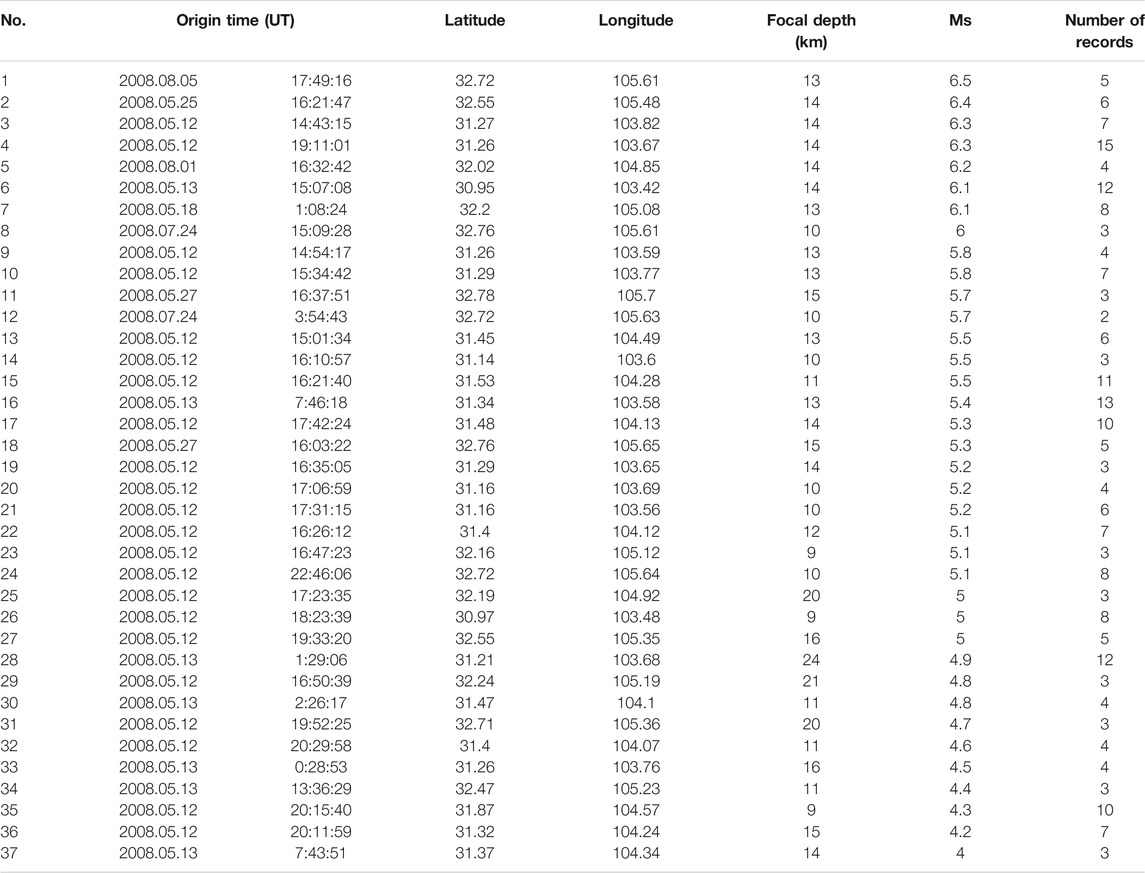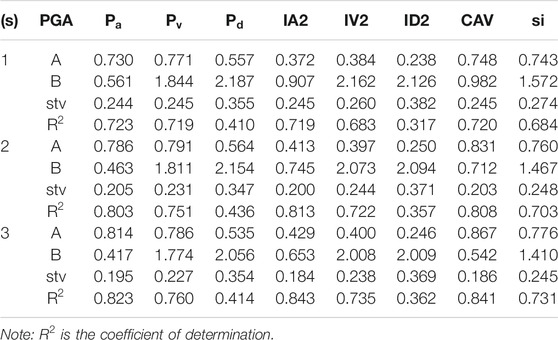- 1Key Laboratory of Urban Underground Engineering of Ministry of Education, Beijing Jiaotong University, Beijing, China
- 2School of Civil Engineering, Beijing Jiaotong University, Beijing, China
The earthquake early warning (EEW) system is capable of mitigating seismic hazards and reducing deaths, injuries, and economic losses. Although EEW approaches have already been developed worldwide, improving the accuracy and applicability is still controversial. Aiming at the ground motion estimation using the initial P wave, we investigated eight representative characteristic parameters, i.e., the peak measurements and integral quantities, using the database of the 2008 Wenchuan earthquake, where the aftershocks with the criteria that 4.0 ≤ Ms ≤ 6.5 and epicentral distance less than 150 km are analyzed. We established the relationships between the eight characteristic parameters and four ground motion parameters, respectively, based on which the estimation accuracy and reliability and the extent to which the increasingly expanding time windows could affect the estimates are analyzed accordingly. We found that the integral quantities could also be a robust estimator for peak ground acceleration (PGA), peak ground velocity (PGV), and spectral intensity (SI), while the peak measurement is more useful in estimating peak ground displacement (PGD). In addition, for estimating the ground motion of events with magnitudes less than 6.5, a 2-s window could effectively improve the estimation accuracy by approximately 11.5–18.5% compared with using a 1-s window, as the window increases to 3 s, the accuracy would further improve while the growth rate will be reduced to around 3.0–8.0%.
Introduction
The earthquake early warning (EEW) system is capable of mitigating seismic hazards and reducing deaths, injuries, and economic losses (Allen and Melgar, 2019; Zollo et al., 2016; Hoshiba, 2014). By regional and on-site algorithms, alerts could be sent ahead of the earthquake events induced ground shaking at target locations so that appropriate measures can be taken immediately against seismic hazards (Cremen and Galasso, 2020; Satriano et al., 2011), e.g., slowing the high-speed trains to reduce accidents and shutting down gas valves to prevent fires in a short term. The EEW systems are generally regarded as positive measures by relevant stakeholders that many earthquake-prone countries and regions are operating or testing their own systems.
The regional approach leverages the information from the seismic network deployed next to the epicenter to evaluate the relevant source parameters (event location and magnitude) and predict the regional seismic intensities using the traditional ground motion prediction equation (GMPE) (Satriano et al., 2011). While on the other hand, the on-site system often consists of a limited set of seismic stations located at particular target sites of interest, which typically provide rapid ground motion estimates, using only information on the characteristics of P waves recorded at one seismic station, where an early warning is often most needed (Kanamori, 2005). A number of algorithms account for the uncertainties of ground motion estimation by considering a confidence interval on the estimate with width equivalent to two standard deviations of the empirical relationship used to derive ground shaking (Wu and Kanamori, 2005; Wu and Kanamori, 2008; Zollo et al., 2010; Zollo et al., 2016).
Western China is an earthquake-prone area with high intensity and frequency, which poses a great threat to the city and transportation system (Xu et al., 2009). For instance, most of the high-speed railways in China have no choice but to be constructed in the areas of moderate to high level of seismic fortification intensity, being prone to derail or overturn in case of dynamic actions and causing catastrophic hazards, even in small seismic events. Effective detection of these events is a necessary condition for disaster prevention and mitigation. However, since China is of a vast territory, it is not possible to set up dense strong ground motion station networks on a large scale at present, and for infrastructures such as high-speed railway which is linearly distributed, it is required to investigate the approach that can be used for single station, which is also expected to improve the reliability of an on-site system, where no information or constraint on the earthquake source is available in real-time.
In this paper, aiming at the ground motion estimation using the initial P wave and among the possible parameters measurable in real-time, i.e., the peak measurements and the integral quantities, we investigated eight representative parameters using the database of the 2008 Wenchuan earthquake (China Strong Motion Networks Centre, 2020). The estimation accuracy and reliability in the established relationships toward four different ground motion parameters are analyzed, respectively. To further investigate that to what an extent the initial signal window length could affect the estimates, we compared the variation tendency of standard deviation and determination coefficient between the leading parameters and the corresponding ground motion parameters of different time window. We found that the integral quantities could also be a robust estimator for PGA, PGV and SI, while the peak measurement is more useful in estimating PGD. In addition, we show that for estimating the ground motion of events with magnitudes less than 6.5, a 1 s of P wave is not enough, while a 2-s window could effectively improve the estimation accuracy, as the window increases to 3 s, the accuracy would further improve while the growth rate is not that much.
Data and Pre-Processing
The 2008 Ms 8.0 Wenchuan earthquake provided an opportunity to collect sound qualified data in a large scale that China Strong Motion Net Centre (CSMNC) recorded 383 aftershocks until September 30, 2008 (China Strong Motion Networks Centre, 2020). More than 600 cases with magnitudes above Ms 4.0 were acquired, among them 56 aftershocks were larger than Ms 5.0 and 8 aftershocks, larger than Ms 6.0. These events were over a rupture length of about 300 km with focal depths ranging from 2 to 20 km. Since the near-fault records of the destructive earthquakes are most important for the EEW system purposes (Nakamura et al., 2011; Satriano et al., 2011), we then selected 37 aftershocks with the criteria that Ms greater than 4.0 and epicentral distance less than 150 km. However, some traces were not recorded from the very beginning that the first P wave arrivals were lost, which were not satisfied with the aim of our study and these cases were discarded.
These records were obtained by the strong motion seismographs with a dynamic range of ±2 g mainly installed at free-field sites and the sampling rate was 200 Hz. We used the proposed three-step detection method to pick the P wave in real-time (Wang and Zhao, 2017) and double checked the arrival time by manual inspection for each waveform. In addition, each record has been checked that the signal noise ratio (SNR) above three is finally adopted (Küperkoch et al., 2010). With the detected P wave, the corresponding early-measured attributes could be calculated based on their formulas or physical meanings. The seismic events studied in this paper are listed in Table 1 while the distributions of these events along the ruptures with the stations are shown in Figure 1.
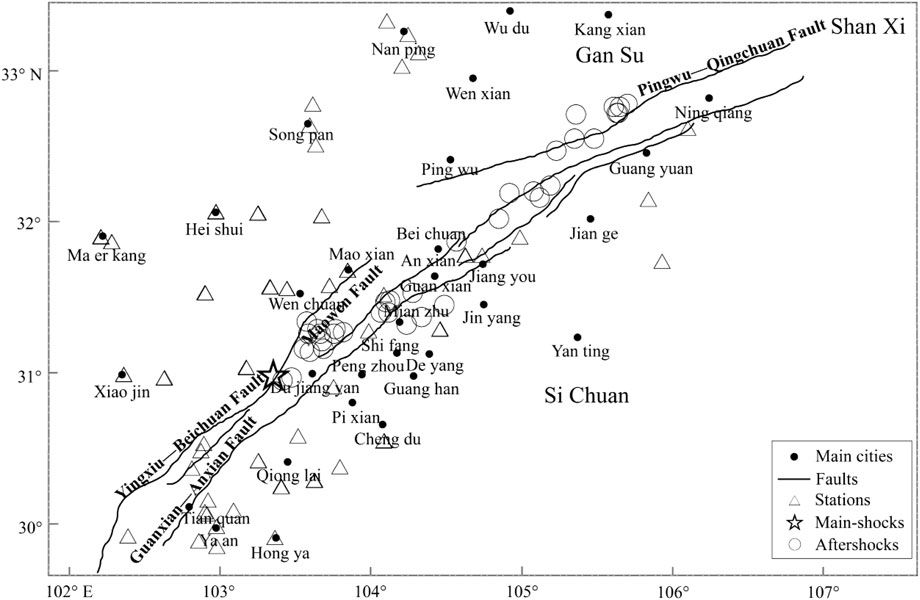
FIGURE 1. Map of stations (triangles) and the main-shock (star) together with the aftershocks (circles) used in this study. A sketch indicating the surface rupture area.
After the baseline error correction for the acceleration records, the signals were integrated to velocity records, and velocity records to displacement records, since they were required in the characteristic parameter calculations. Then, we applied a causal two-pole Butterworth filter with a cut-off frequency of 0.075 Hz on the vertical component to remove the undesired long-period trends after numerical integration (Boore et al., 2002). Zollo et al. (2010) have shown that this cut-off frequency preserves a scaling of the EEW parameters with magnitude in a broad range.
EEW Parameters Versus Ground Motion Parameters
The strengths of critical ground motions can be defined by the shock wave, where its effects are practically represented by the peak ground acceleration (PGA), peak ground velocity (PGV), and peak ground displacement (PGD). In addition, the spectral intensity (SI) is defined as follows by Housner who regarded it as a seismic index reflecting the earthquake destructive power (Housner, 1952):
where
Therefore, for the EEW purposes, we used the PGA, PGV, PGD, and SI as parameters to assess the strengths of the ground motions during earthquake damage.
Normally a certain time window following the initial P wave arrival time
Therefore, on the basis of the initial P wave arrival time
where the
Results
Since better estimates might be obtained by expanding the observation time window to update the characteristic parameters, the time windows of 1 s to 3 s are investigated, respectively. Under the current analytical form, the resulting best-fitting regression coefficients for the four ground motion parameters and the corresponding characteristic parameters are listed in Tables 2, 5.
With the calculated standard deviation
With the corresponding leading parameters for estimating the four ground motion parameters, Figures 2, 5 illustrate the linear regressions curves aiming PGA, PGV, PGD, and SI, respectively. In each figure, the characteristic parameters calculated from the first 1 s, 2 s, and 3 s are shown with circles, squares, and triangles, respectively, where the solid line refers to the regression relationship while the dashed lines stand for the standard deviations. The regression curves show that the investigated characteristic parameters correlate well with the ground motion parameters, and the uncertainties of the ground motion determination for the events reduce along with the increases of the time windows, since most of the seismic accumulated energy could be released in a short time.
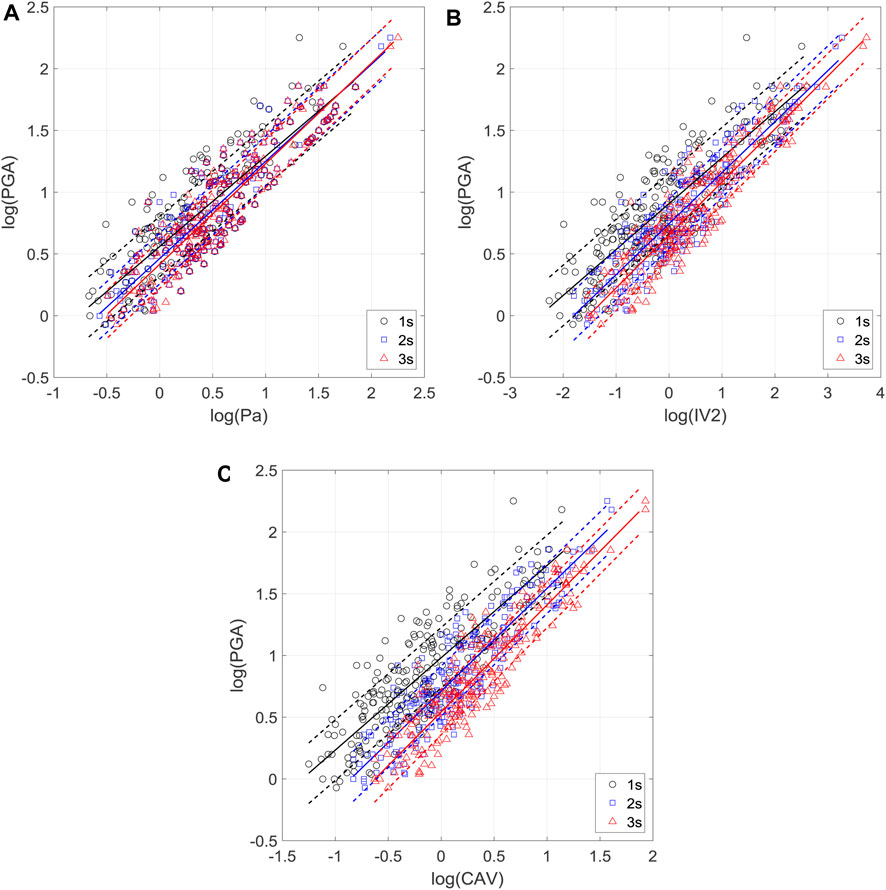
FIGURE 2. (A–C) show

FIGURE 3. (A–D) show
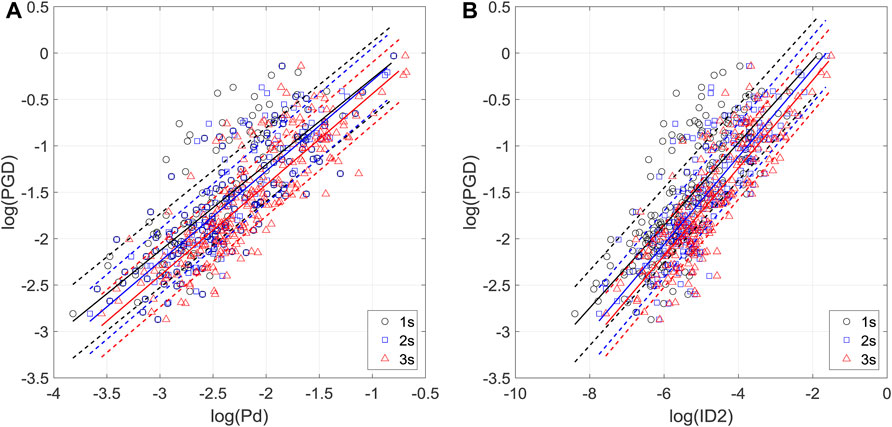
FIGURE 4. (A–B) show
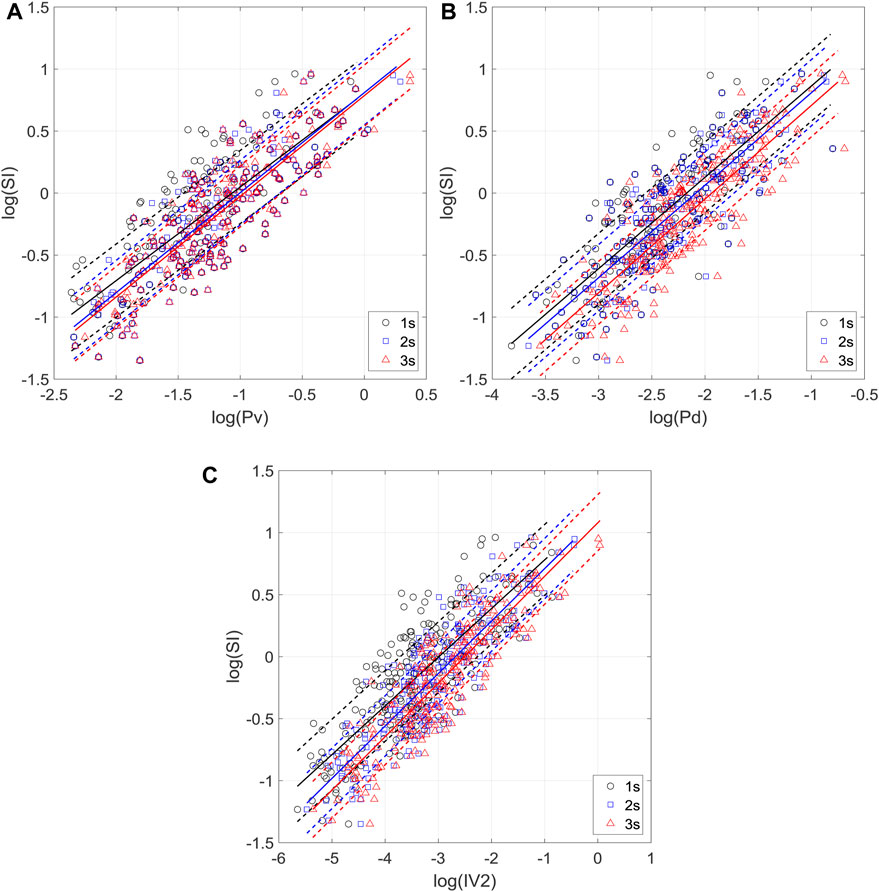
FIGURE 5. (A–C) show
To further investigate that to what an extent the length of the initial signal window could affect the estimations, we compared the variation tendency of standard deviation and determination coefficient between the leading parameters and the corresponding ground motion parameters of different time window, which are shown in Figure 6. From the variation slope of each investigated parameter, both
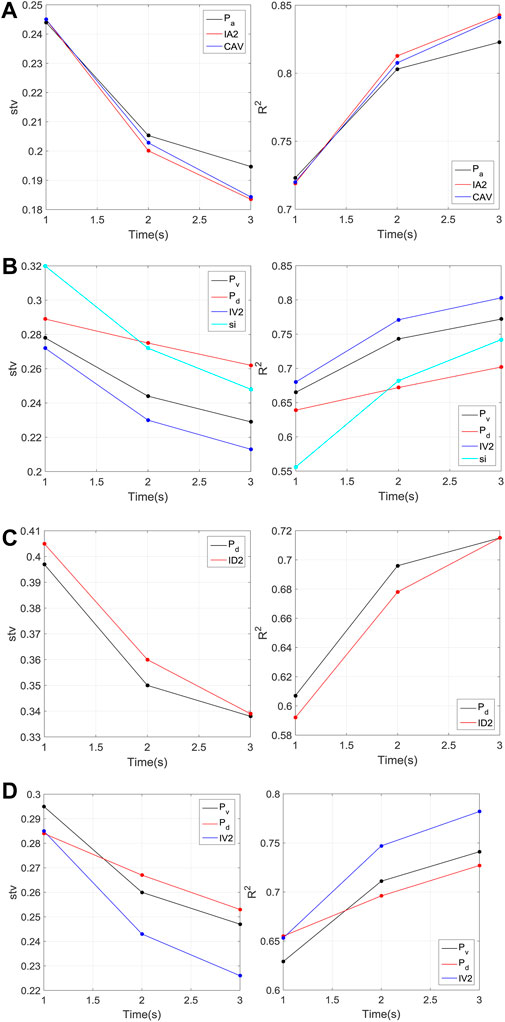
FIGURE 6. Comparison of the standard deviation and coefficient of determination between the leading parameters for estimating (A) PGA, (B) PGV, (C) PGD, and (D) SI, respectively.
Discussion and Conclusion
In this paper, the proposed method is envisaged to be based on a single station and is expected to improve the reliability of an on-site system, where no information or constraint on the earthquake source is available in real-time. Aiming at the ground motion estimation using the initial P wave, we have investigated the continuous measurement of eight attributes for the fast prediction of the expected shaking at the same site, where the estimation accuracy and reliability toward different ground motion parameters and to what an extent that the length of the signal window could affect the estimates are proposed. Although the single station method is conceived, the methodology proposed here could be easily integrated in a network-based EEW platform.
The EEW characteristic parameters, i.e.,
The integral quantities, i.e.,
Since time is the key parameter of the early warning system, the longer the available time before the disaster phenomenon reaches the target, the more effective and comprehensive the countermeasures can be taken. In contrast of regional EEW systems, which yield more accurate estimates of the source parameters, the on-site EEW systems could provide faster warning times for near-source targets at the price of a lower accuracy on the estimation of earthquake parameters. There is always a trade-off between the early warning time and the reliability of earthquake information. From our results, a 2-s window could effectively improve the estimation accuracy by approximately 11.5–18.5% compared with using a 1-s window, as the window increases to 3 s, the accuracy would further improve while the growth rate will be reduced to around 3.0–8.0%. That is to say, for appropriate correlations between the characteristic parameters and ground motion parameters, a 2 s initial P wave might be enough for the first alert; meanwhile, the updating procedures should be considered certainly in real operations.
The 2008 Ms 8.0 Wenchuan earthquake occurred along the Longmenshan faults (Li et al., 2008), consisting of mountain-front fault, central fault, and mountain-back fault, which are situated in the transitional area from the Tibetan Plateau to the South China Plate. This complicated geological and topographic environment caused complex focal mechanisms, propagation processes, and site effects, resulting in the ground motions to have the nature of complexity. Because aftershocks distribute on different secondary faults, their focal mechanisms present complex local tectonic stress field and even vary with time. Generally, for the southern segment, the thrust component is stronger than strike-slip component, while the northern segment corresponds to a section of mostly strike-slip mechanism; the middle segment may be related to the transition between the southern and northern segments (Zheng et al., 2010; Yi et al., 2012), since the used data cover the general magnitude gradients that are of concern for EEW systems, and multiple stations recorded the wave forms for each event within the specified range, providing important benefits for EEW studies. In addition, the earthquake rupture and the propagation process should be investigated and studied to develop a better theoretical research of the phase nature.
The paper tested different attributes for the fast prediction of the expected shaking in real-time, while practical operations require consideration of other aspects. For example, the observation stations should be built with the ability to provide early warnings that the detection instruments are capable of improving the signal quality, especially for the vertical component. In addition, appropriate investigations of the observation locations with detailed surrounding seismic environments are also necessary. When calibrating the proposed method for a specific area, the possible impact of site effect, which may produce local, systematic amplification/attenuation of the perceived shaking, is required to have a detailed analysis.
Data Availability Statement
The original contributions presented in the study are included in the article/Supplementary Material; further inquiries can be directed to the corresponding author.
Author Contributions
ZW: conceptualization, methodology, data analysis, visualization, and writing the original draft. BZ: methodology, writing—review and editing, and supervision.
Funding
This research has been supported by the National Natural Science Foundation of China (Grant Nos. 51808045; 51778046; U1434210), the Research Grants from the National Institute of Natural Hazards, Ministry of Emergency Management of China (Grant No. ZDJ2020-14), and the Fundamental Research Funds for the Central Universities (2019RC047).
Conflict of Interest
The authors declare that the research was conducted in the absence of any commercial or financial relationships that could be construed as a potential conflict of interest.
Publisher’s Note
All claims expressed in this article are solely those of the authors and do not necessarily represent those of their affiliated organizations, or those of the publisher, the editors, and the reviewers. Any product that may be evaluated in this article, or claim that may be made by its manufacturer, is not guaranteed or endorsed by the publisher.
Acknowledgments
We would like to thank the China Strong Motion Net Centre for the recorded data.
References
Allen, R. M., and Melgar, D. (2019). Earthquake Early Warning: Advances, Scientific Challenges, and Societal Needs. Annu. Rev. Earth Planet. Sci. 47, 361–388. doi:10.1146/annurev-earth-053018-060457
Allen, R. M., Gasparini, P., Kamigaichi, O., and Böse, M. (2009). The Status of Earthquake Early Warning Around the World: An Introductory Overview. Seismological Res. Lett. 80, 682–693. doi:10.1785/gssrl.80.5.682
Boore, D. M., Stephens, C. D., and Joyner, W. B. (2002). Comments on Baseline Correction of Digital strong-motion Data: Examples from the 1999 Hector Mine, California, Earthquake. Bull. Seismological Soc. America 92, 1543–1560. doi:10.1785/0120000926
Bose, M., Hauksson, E., Solanki, K., Kanamori, H., Wu, Y.-M., and Heaton, T. H. (2009). A New Trigger Criterion for Improved Real-Time Performance of Onsite Earthquake Early Warning in Southern California. Bull. Seismological Soc. America 99 (2A), 897–905. doi:10.1785/0120080034
China Strong Motion Networks Centre (2020). China Strong Motion Networks Centre. Available at: www.cenc.ac.cn (Accessed November 05, 2020).
Colombelli, S., Caruso, A., Zollo, A., Festa, G., and Kanamori, H. (2015). A P Wave‐based, On‐site Method for Earthquake Early Warning. Geophys. Res. Lett. 42, 1390–1398. doi:10.1002/2014gl063002
Colombelli, S., and Zollo, A. (2016). Rapid and Reliable Seismic Source Characterization in Earthquake Early Warning Systems: Current Methodologies, Results, and New Perspectives. J. Seismol. 20 (4), 1–16. doi:10.1007/s10950-016-9570-z
Cremen, G., and Galasso, C. (2020). Earthquake Early Warning: Recent Advances and Perspectives. Earth-Science Rev. 205, 103184. doi:10.1016/j.earscirev.2020.103184
Erdik, M., Fahjan, Y., Ozel, O., Alcik, H., Mert, A., and Gul, M. (2003). Istanbul Earthquake Rapid Response and the Early Warning System. Bull. Earthquake. Eng. 1, 157–163. doi:10.1023/a:1024813612271
Festa, G., Zollo, A., and Lancieri, M. (2008). Earthquake Magnitude Estimation from Early Radiated Energy. Geophys. Res. Lett. 35, L22307. doi:10.1029/2008gl035576
Hoshiba, M. (2014). Review of the Nationwide Earthquake Early Warning in Japan during its First Five Years. Earthquake Hazard. Risk Disasters 2014, 509–529. doi:10.1016/b978-0-12-394848-9.00019-5
Housner, G. W. (1952). Intensity of Ground Motion during Strong Earthquakes. California: California Institute of Technology.
Kanamori, H. (2005). Real-Time Seismology and Earthquake Damage Mitigation. Annu. Rev. Earth Planet. Sci. 33, 195–214. doi:10.1146/annurev.earth.33.092203.122626
Küperkoch, L., Meier, T., Lee, J., and Friederich, W.EGELADOS Working Group (2010). Automated Determination of P-phase Arrival Times at Regional and Local Distances Using Higher Order Statistics. Geophys. J. Int. 181, 1159–1170. doi:10.1111/j.1365-246x.2010.04570.x
Li, Z. Q., Yuan, Y. F., Li, X. L., and Zeng, J. (2008). Preliminary Research on the Characteristics of the Ms 8.0 Wenchuan Earthquake hazard. Seismol. Geol. 30 (4), 855–876.
Nakamura, Y., Saita, J., and Sato, T. (2011). On an Earthquake Early Warning System (EEW) and its Applications. Soil Dyn. Earthquake Eng. 31, 127–136. doi:10.1016/j.soildyn.2010.04.012
Satriano, C., Wu, Y.-M., Zollo, A., and Kanamori, H. (2011). Earthquake Early Warning: Concepts, Methods and Physical Grounds. Soil Dyn. Earthquake Eng. 31, 106–118. doi:10.1016/j.soildyn.2010.07.007
Wang, Z., and Zhao, B. (2017). Automatic Event Detection and Picking of P, S Seismic Phases for Earthquake Early Warning and Application for the 2008 Wenchuan Earthquake. Soil Dyn. Earthquake Eng. 97, 172–181. doi:10.1016/j.soildyn.2017.03.017
Wang, Z., and Zhao, B. (2018). Method of Accurate-Fast Magnitude Estimation for Earthquake Early Warning -----Trial and Application for the 2008 Wenchuan Earthquake. Soil Dyn. Earthquake Eng. 109, 227–234. doi:10.1016/j.soildyn.2018.03.006
Wu, Y.-M., and Kanamori, H. (2008). Development of an Earthquake Early Warning System Using Real-Time strong Motion Signals. Sensors 8 (1), 1–9. doi:10.3390/s8010001
Wu, Y.-M., and Kanamori, H. (2005). Rapid Assessment of Damage Potential of Earthquakes in Taiwan from the Beginning of P Waves. Bull. Seismological Soc. America 95 (3), 1181–1185. doi:10.1785/0120040193
Xu, X., Wen, X., Yu, G., Chen, G., Klinger, Y., Hubbard, J., et al. (2009). Coseismic Reverse- and Oblique-Slip Surface Faulting Generated by the 2008 Mw 7.9 Wenchuan Earthquake, China. Geology 37, 515–518. doi:10.1130/g25462a.1
Yi, G. X., Long, F., and Zhang, Z. W. (2012). Spatial and Temporal Variation of Focal Mechanisms for Aftershocks of the 2008 Ms8.0 Wenchuan Earthquake. Chin. J. Geophys. 55 (4), 1213–1227.
Zheng, Y., Ni, S., Xie, Z., Lv, J., Ma, H., and Sommerville, P. (2010). Strong Aftershocks in the Northern Segment of the Wenchuan Earthquake Rupture Zone and Their Seismotectonic Implications. Earth Planet. Sp 62 (11), 881–886. doi:10.5047/eps.2009.06.001
Zollo, A., Amoroso, O., Lancieri, M., Wu, Y.-M., and Kanamori, H. (2010). A Threshold-Based Earthquake Early Warning Using Dense Accelerometer Networks. Geophys. J. Int. 183, 963–974. doi:10.1111/j.1365-246x.2010.04765.x
Keywords: earthquake early warning, ground motion estimation, Wenchuan earthquake, initial P wave, characteristic parameters
Citation: Wang Z and Zhao B (2021) Applicability of Accurate Ground Motion Estimation Using Initial P Wave for Earthquake Early Warning. Front. Earth Sci. 9:718216. doi: 10.3389/feart.2021.718216
Received: 31 May 2021; Accepted: 19 August 2021;
Published: 13 September 2021.
Edited by:
Huseyin Serdar Kuyuk, Harvard University, United StatesReviewed by:
Jia Cheng, Ministry of Emergency Management, ChinaAli Pinar, Boğaziçi University, Turkey
Copyright © 2021 Wang and Zhao. This is an open-access article distributed under the terms of the Creative Commons Attribution License (CC BY). The use, distribution or reproduction in other forums is permitted, provided the original author(s) and the copyright owner(s) are credited and that the original publication in this journal is cited, in accordance with accepted academic practice. No use, distribution or reproduction is permitted which does not comply with these terms.
*Correspondence: Boming Zhao, Ym16aGFvQGJqdHUuZWR1LmNu
 Zijun Wang
Zijun Wang Boming Zhao
Boming Zhao